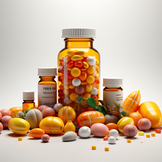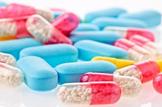What is the mechanism of action of sildenafil (viagra) for erectile dysfunction?
- Understanding Sildenafil (Viagra)
- The Role of Increased Blood Flow in Achieving an Erection
- Sildenafil's Mechanism of Action as a PDE-5 Inhibitor
- Safety Comparison with Erection Injectables and Priapism Prevention
- The Role of Sexual Stimulation in the Effectiveness of Sildenafil
- Clinical Studies and Meta-Analysis on Sildenafil's Effectiveness
- Efficacy in Psychogenic and Organic Erectile Dysfunction
- The Role of Nitric Oxide (NO) and Corpus Cavernosum in Penile Erection
- PDE-5 and its Significance in cGMP Metabolism
- The Role of Cyclic Guanosine Monophosphate (cGMP) in Penile Erection
- The Effect of Sildenafil on Smooth Muscle Relaxation and Vasodilation
- Limitations of Sildenafil: No Effect on Sexual Desire, Pregnancy, and Sexually Transmitted Diseases (STDs)

Understanding Sildenafil (Viagra)
Sildenafil, often recognized by its brand name Viagra, is an oral therapy commonly used to treat erectile dysfunction (ED). It has been a significant breakthrough in the field, providing an effective and convenient option for millions of men.
The Role of Increased Blood Flow in Achieving an Erection
Blood flow plays a crucial role in achieving an erection.
The penis houses two cylinder-shaped structures, the corpora cavernosa, which run the length of the organ.Sexual stimulation causes the smooth muscles in these structures to relax, allowing more blood to flow into the penis.This influx of blood engorges the corpora cavernosa, causing the penis to expand and become erect.
Sildenafil's Mechanism of Action as a PDE-5 Inhibitor
Sildenafil is classified as a phosphodiesterase type V inhibitor (PDE-5 inhibitor). It works by targeting phosphodiesterase enzymes, particularly PDE-5, that are responsible for breaking down a molecule known as cyclic guanosine monophosphate (cGMP). The presence of cGMP is vital for penile erection as it promotes relaxation of smooth muscles and vasodilation within the penis.
Safety Comparison with Erection Injectables and Priapism Prevention
Compared to other treatments like erection injectables, Sildenafil provides a safer and non-invasive option. While injectables can also increase blood flow to the penis, they carry risks such as pain or priapism, a condition where an erection lasts too long and can cause permanent damage. By selectively inhibiting PDE-5, Sildenafil reduces the likelihood of these side effects.
The Role of Sexual Stimulation in the Effectiveness of Sildenafil
One critical aspect of Sildenafil is that it does not directly cause an erection; instead, it facilitates the biological processes necessary for an erection to occur in response to sexual stimulation. Thus, without sexual stimulation, the drug will not result in an erection.
Clinical Studies and Meta-Analysis on Sildenafil's Effectiveness
Multiple clinical studies and meta-analyses have shown the effectiveness of Sildenafil. A notable multicenter double-blind randomized study involving 861 patients demonstrated significant improvements in erectile function with Sildenafil use. Furthermore, a meta-analysis of 10 studies provided consistent results, further solidifying Sildenafil's efficacy.
Efficacy in Psychogenic and Organic Erectile Dysfunction
The effectiveness of Sildenafil extends to both psychogenic and organic erectile dysfunction. Regardless of the cause of ED, Sildenafil enhances the erectile response when a man is sexually stimulated.
The Role of Nitric Oxide (NO) and Corpus Cavernosum in Penile Erection
Nitric oxide (NO) plays a key role in inducing an erection. Upon sexual stimulation, NO is released in the corpus cavernosum, triggering the production of cGMP. As previously mentioned, cGMP then leads to smooth muscle relaxation and vasodilation, contributing to an erection.
PDE-5 and its Significance in cGMP Metabolism
PDE-5 is an enzyme primarily found in the smooth muscle of the corpus cavernosum that breaks down cGMP. Therefore, it plays a significant role in controlling the level of cGMP, which is critical for the erection process.
The Role of Cyclic Guanosine Monophosphate (cGMP) in Penile Erection
cGMP is a molecule that triggers smooth muscle relaxation in the penis, leading to increased blood flow and an erection. Thus, cGMP is essential for initiating the physiological process that results in an erection.
The Effect of Sildenafil on Smooth Muscle Relaxation and Vasodilation
Sildenafil's main mechanism is to inhibit the breakdown of cGMP by blocking the action of PDE-5. This action ensures a high level of cGMP in the penis, leading to prolonged smooth muscle relaxation and vasodilation and hence, a more sustainable erection.
Limitations of Sildenafil: No Effect on Sexual Desire, Pregnancy, and Sexually Transmitted Diseases (STDs)
While Sildenafil is effective in treating ED, it does not increase sexual desire or libido. It is not a hormone and does not affect the psychological aspects of sexual desire. Moreover, it does not protect against sexually transmitted diseases, including human immunodeficiency virus (HIV), and does not have any impact on pregnancy.
In conclusion, Sildenafil is an effective and safe treatment for erectile dysfunction. It works by inhibiting PDE-5 and preserving the level of cGMP in the penis, leading to prolonged erection upon sexual stimulation. However, it does not enhance sexual desire or provide protection against STDs, and its effectiveness is not immediate without sexual stimulation.



